What Structures Do Animal Cells Have That Plants Don't
Definition: What is a cell?
The cell is the basic unit of measurement or edifice cake of living organisms. The prison cell was commencement observed and discovered nether a microscope by Robert Hooke in 1665. The word "cell" came from Latin, which means "small room." The cell membrane encloses the content of the prison cell and separates all biological activities from the exterior globe. Tiny structural parts within the prison cell, called organelles, are involved in diverse specialized functions to proceed the cell alive and active.
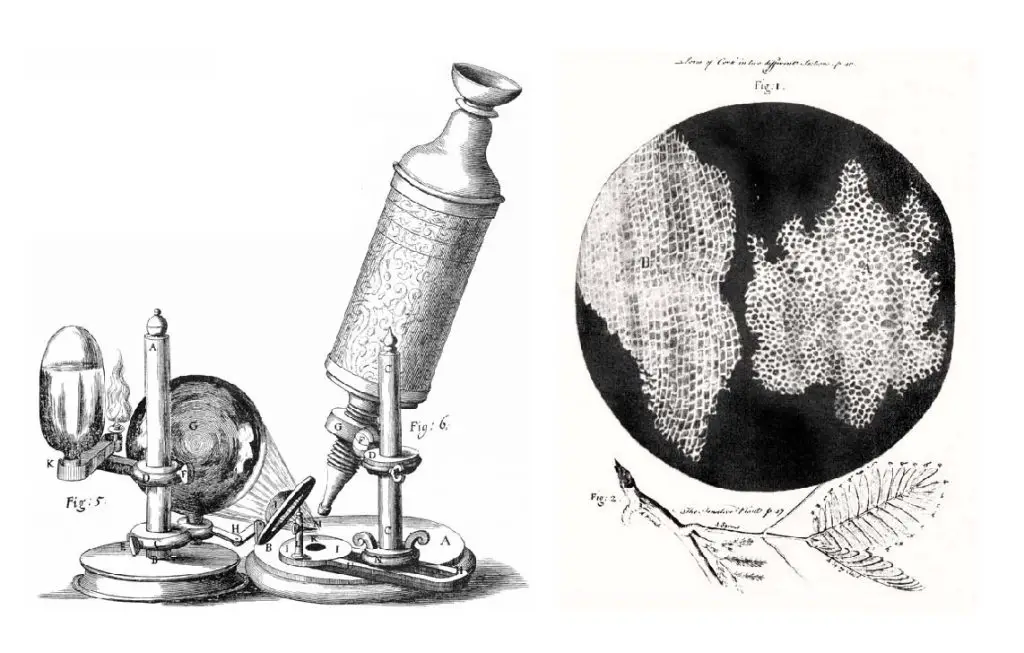
[In this figure] Left: The compound microscope used past Robert Hooke to discover "cells." Right: Cell structure of cork illuminated by Robert Hooke inMicrographia, 1665.
Definition: What are animals, and what are plants?
Animals are multicellular organisms that form the biological kingdom Animalia. They all have characteristics as:
- Heterotroph – cannot produce its own nutrient. Instead, taking diet from other sources
- Consume oxygen
- Able to move
- Reproduce sexually
Plants are multicellular organisms of the kingdom Plantae. Their features include:
- Autotroph – can produce its own food using calorie-free, water, carbon dioxide, or other chemicals
- Both consume and produce oxygen
- Mostly, do not motility
- Reproduce sexually and asexually

[In this effigy] Tree of living organisms showing the origins of eukaryotes and prokaryotes.
Photograph source: wiki.
Animal cells vs. Found cells – Key similarities
Animal cells and found cells are eukaryotic cells
Both animal and establish cells are classified as "Eukaryotic cells," pregnant they possess a "true nucleus." Compared to "Prokaryotic cells," such every bit bacteria or archaea, eukaryotic cells' DNA is enclosed in a membrane-leap nucleus. These membranes are similar to the jail cell membrane, which is a flexible pic of lipid bilayers. Eukaryotes also take several membrane-bound organelles. Organelles are internal structures responsible for various functions, such as free energy production and poly peptide synthesis.
Both animals and plants are multicellular organisms
Based on the current biological nomenclature, both animals and plants are multicellular organisms, meaning that they consist of more than than one cell. Different types of cells in a multicellular organism dedicate to unlike jobs.
For example, cardiac muscle cells pump blood to circulate the body while intestinal cells blot nutrients from the gut lumen into the bloodstream. Many cells assemble into a specific type of "tissue." I or more tissues piece of work together as an "organ." Several organs bring together forces to carry out a specific physiological task and class a "arrangement."
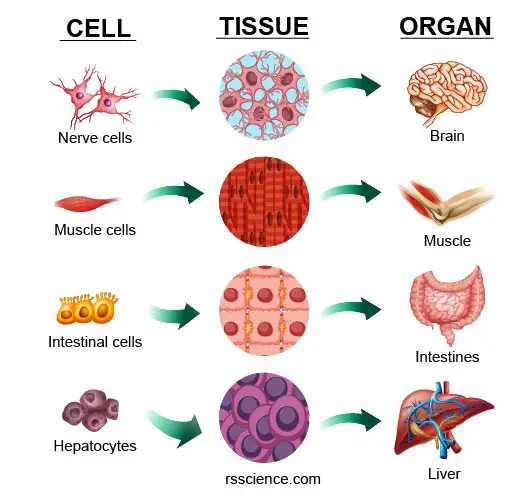
There is a grey zone in the electric current biological classification, called Protista. The Protista, or Protoctista, is a kingdom of simple eukaryotic organisms, commonly composed of a single cell or a colony of similar cells. A protist is not an animal, found, or mucus. Withal, some protists may deport like animals or plants.
For example, protozoans are grouped every bit animal-like protists, and algae are referred to equally mixed groups of found-like protists. Interestingly, some species confuse the scientists by exhibiting both characteristics of animate being and plant. The best case is Euglena, a single-celled microorganism that tin can harvest solar free energy past its chloroplasts like a institute, simply as well swim around using its flagellum like an animal.
Animal cell structures
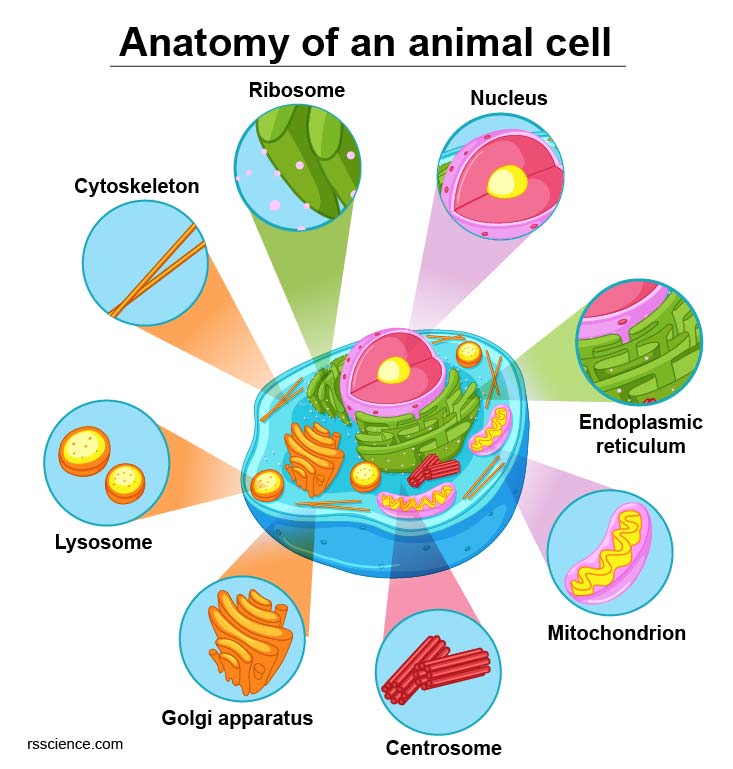
[In this figure] Diagram of an animal cell.
Institute prison cell structures

[In this effigy] Diagram of a institute cell.
Prison cell organelles and their functions
Like different organs within the trunk, beast and plant cells include various components known as cell organelles that perform different functions to sustain the cells every bit a whole. These organelles include:
| Cell feature | Function | Membrane-jump organelle (Yes or No) | Present in Animal (A) or Plant (P) cells |
| Nucleus | A primal place to store the genetic information (genome) of the prison cell. | Y | A, P |
| Nucleolus | A core inside the eukaryotic nucleus where ribosomal RNA is produced. | N | A, P |
| Nuclear envelope | The membrane separated the nucleus and cytoplasm. | Y | A, P |
| Cytoplasm | The office of the cell between the nuclear envelope and plasma membrane. | N | A, P |
| Cytosol | Gel-like cellular fluid filled up the intracellular space. | N | A, P |
| Jail cell membrane | Also known as the plasma membrane, a phospholipid bilayer that surrounds the entire cell and encompasses the organelles inside. | Y | A, P |
| Prison cell wall | Provides structure and protection from the exterior environment. Only in plants and fungi. | N | P |
| Vacuole | A membrane-bound organelle that contains a mass of fluid and functions as a storage space. Large central vacuole is merely existing in plant cells. | Y | P |
| Chloroplast | An organelle that conducts photosynthesis and produces energy for the found cells. | Y | P |
| Amyloplast | An organelle that produces and stores starch; ordinarily found in vegetative plant tissues. | Y | P |
| Cytoskeleton | A dynamic network responsive for cell movement, division, and intracellular transportation | N | A, P |
| Mitochondrion | As well known equally the powerhouse of the cell, information technology is responsible for energy production. | Y | A, P |
| Ribosome | The site for protein synthesis. | Northward | A, P |
| Endoplasmic reticulum | An internal membrane that forms branching networks and coordinates poly peptide synthesis. | Y | A, P |
| Golgi apparatus | A membrane-bounded organelle defended to protein maturation and transportation. | Y | A, P |
| Lysosome | An organelle full of digestive enzymes and works like a recycling middle in the cell. | Y | A, P |
| Peroxisome | An organelle responsible for the fatty acid breakdown and other redox reactions. | Y | A, P |
Animal cells vs. Plant cells – major differences
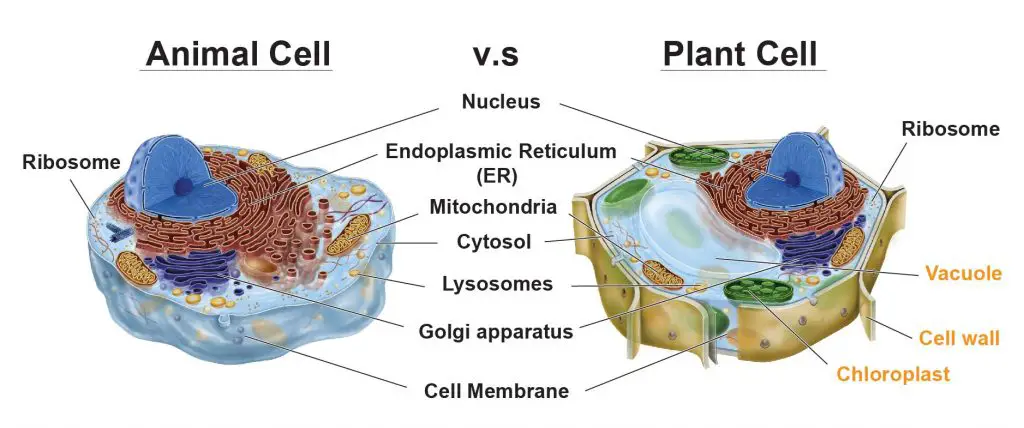
[In this figure] The cell anatomy of animal and plant cells.
The animal prison cell and found jail cell share many organelles in mutual, such as a nucleus, ER, cytosol, lysosomes, Golgi apparatus, prison cell membrane, and ribosomes. The organelles unique for institute cells are vacuole, jail cell wall, and chloroplast (shown in orangish text).
The nigh striking divergence between animate being cells and plant cells is that found cells accept 3 unique organelles: central vacuole, jail cell wall, and chloroplast. We summarize the major differences between plant and beast cells in this table.
| Characteristics | Plant cells | Animal cells |
| Classification | Eukaryotic jail cell | Eukaryotic jail cell |
| Cell size | Unremarkably larger in size | Smaller in size |
| Cell shape | A rectangular fixed shape | A round irregular shape |
| Motility | Limited movement | Jail cell can move around by irresolute its shape |
| Plasma membrane | Nowadays; don't contain cholesterol | Present; contain cholesterol |
| Jail cell wall | Composed of a prison cell wall made up of cellulose | No jail cell wall |
| Vacuole | Accept ane, large, permanent, fundamental vacuole taking upwards to 90% of cell volume | Ane or more small, temporary vacuoles (much smaller than plant cells) |
| Tonoplast | Tonoplast present effectually vacuole | Absent |
| Chloroplast | Contain chloroplasts to perform photosynthesis | No chloroplast |
| Plastid | Nowadays; various types | Absent-minded |
| Nucleus | Nucleus present along the peripheral of the cell | Nucleus present at the eye of the cell |
| Centriole/ Centrosome | Just present in lower plant forms (e.g. chlamydomonas) | Present in all animal cells |
| Golgi apparatus | Have several simpler Golgi | Have a unmarried highly circuitous Golgi |
| Mitochondrion | Present | Present |
| Endoplasmic Reticulum/Ribosome | Nowadays | Present |
| Lysosome | Maybe present; vacuole too function as a degrading site | Nowadays |
| Peroxisome | Nowadays; specialized equally glyoxysomes | Nowadays |
| Plasmodesmata | Nowadays | Absent |
| Flagellum | Nowadays in some cells (e.1000. sperm of bryophytes and pteridophytes, cycads and Ginkgo) | Present in some cells (e.g. mammalian sperm cells) |
| Cilia | Absent | Nowadays in some cells |
| Storage | Reserve food in the form of starch | Reserve food in the form of glycogen |
| Mitosis | Spindle formation is anastral (no aster) | Spindle formation is amphiastral (two asters) |
| Energy source | Autotroph | Heterotroph |
Cell Wall
A divergence between institute cells and animal cells is that establish cells have a rigid cell wall that surrounds the cell membrane. Animal cells do not have a prison cell wall. As a outcome, most animal cells are circular and flexible, whereas about plant cells are rectangular and rigid. When looking under a microscope, the prison cell wall is an like shooting fish in a barrel feature to distinguish plant cells.
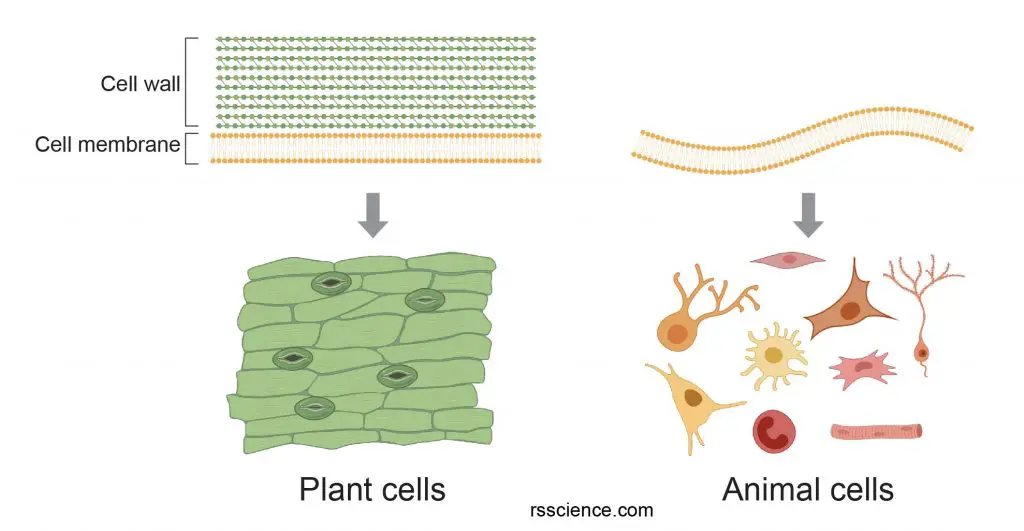
[In this figure] Jail cell wall provides additional protective layers outside the cell membrane.
Chloroplasts
Plants are autotrophs, meaning they produce energy from sunlight through the procedure of photosynthesis. This function depends on the organelles chosen chloroplasts. Beast cells practice not have chloroplasts. In animal cells, energy is produced from nutrient (glucose) via a procedure of cellular respiration. Cellular respiration occurs in mitochondria in both animal and plant cells.
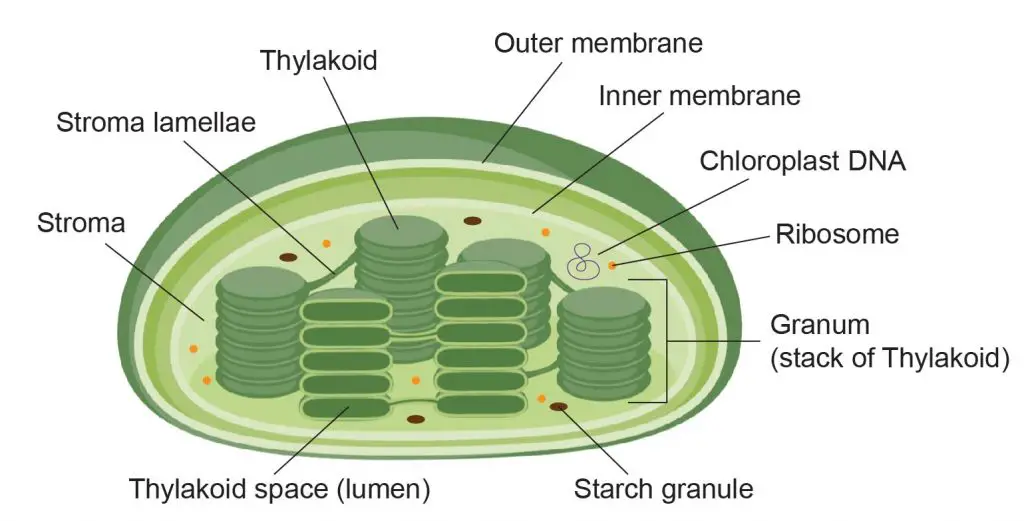
[In this figure] The structure of a chloroplast.
Plastids
Plastids are double-membrane organelles that are found in the cells of plants and algae. Plastids are responsible for manufacturing and storing food. Plastids frequently incorporate pigments that are used in photosynthesis and different types of pigments can change the colour of the cell. Chloroplasts are the most prominent blazon of plastids. Other plastids, similar chromoplasts, gerontoplasts, and leucoplasts, may merely occur in certain plant cells.
Vacuoles
Animate being cells accept one or more modest vacuoles, whereas plant cells have one large fundamental vacuole that tin take upward to 90% of the prison cell volume. The function of vacuoles in plants is to store h2o and maintain the turgidity of the prison cell. Sometimes, vacuoles in plants also dethrone cellular wastes like lysosomes. A layer of membrane, called tonoplast, surrounds the plant prison cell'southward central vacuole. Due to the large size of the central vacuole, it pushes all contents of the prison cell'southward cytoplasm and organelles against the cell wall. This may facilitate the cytoplasmic streaming of chloroplasts.
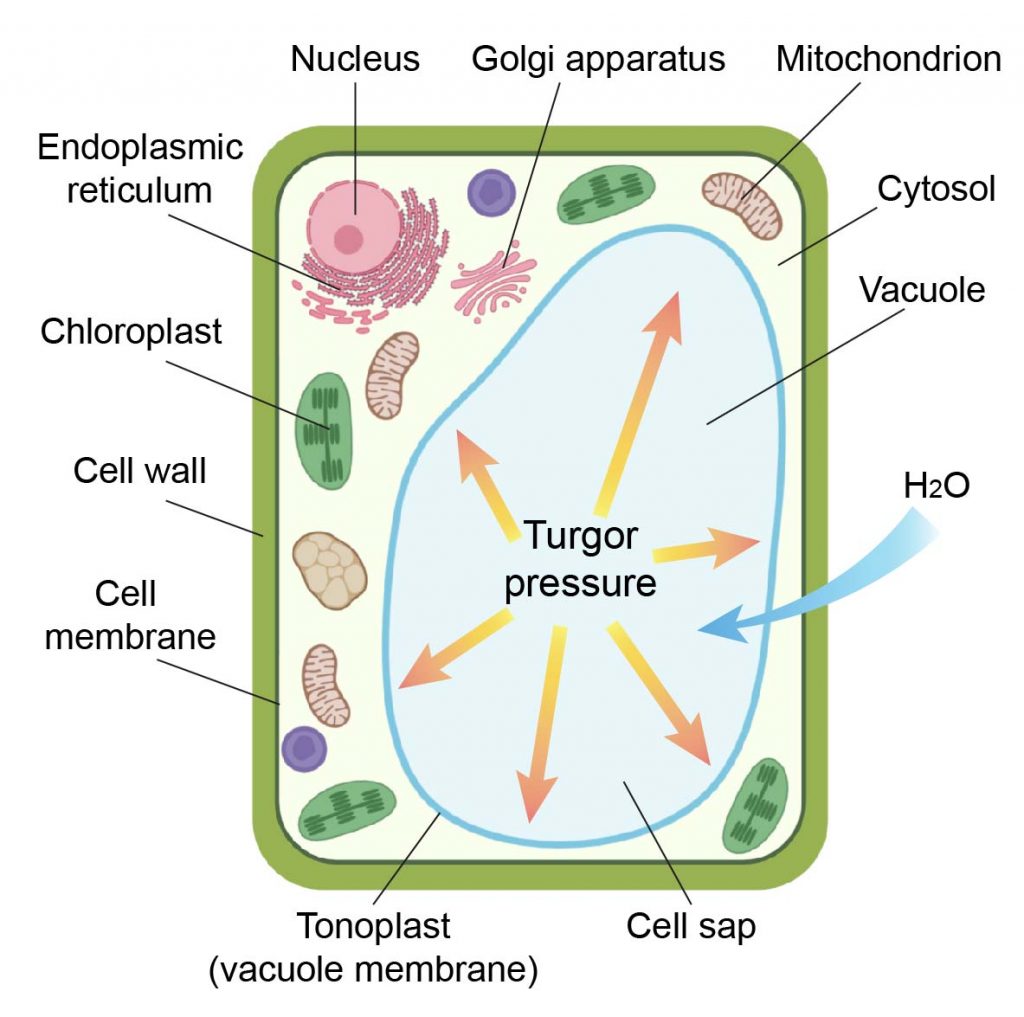
[In this effigy] Drawing of a constitute cell showing a big vacuole.
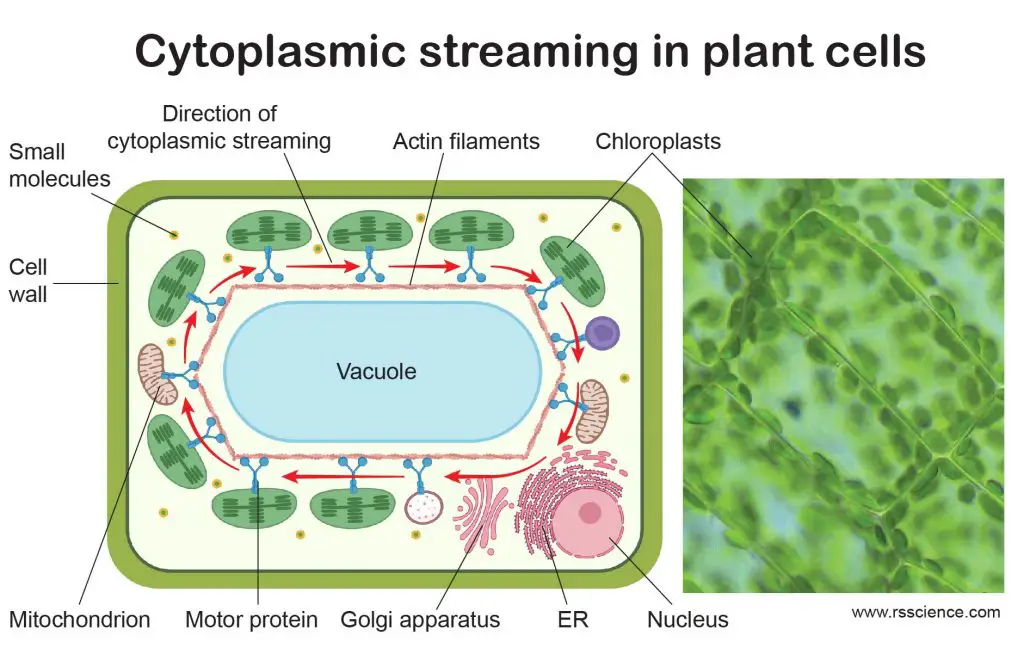
[In this effigy]Cytoplasmic streaming in plant cells.
Cytoplasmic streaming circulates the chloroplasts around the primal vacuoles in plant cells. This optimizes the exposure of light on every single chloroplast evenly, maximizing the efficiency of photosynthesis. The right epitome is the bodily cytoplasmic streaming of chloroplasts in Elodea cells.
Created with BioRender.com
Centriole
Centrioles are paired barrel-shaped organelles (centrosomes) located in the cytoplasm of beast cells near the nuclear envelope. All animal cells have centrioles, whereas only some lower plant forms take centrioles in their cells (e.g., the male gametes of charophytes, bryophytes, seedless vascular plants, cycads, and ginkgo).
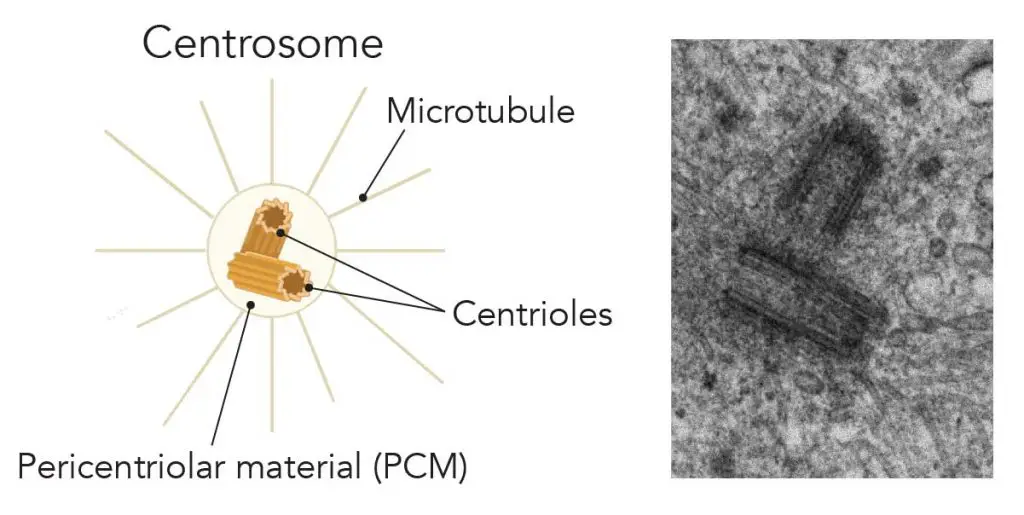
[In this effigy] Illustration and electron micrography of the centrosome.
Left: Centrosomes are equanimous of two centrioles arranged at right-angles to each other and surrounded by proteins called the pericentriolar textile (PCM). Microtubule fibers grow from the PCM. Right: Electron microscopic images of centrioles. (Image: johan-nygren)
Lysosome
The lysosomes are small-scale organelles that work equally the recycling middle in the cells. They are membrane-divisional spheres full of digesting enzymes. Lysosomes were considered to be exclusive to animal cells. However, this statement became controversial. Plant vacuoles are found to be much more diverse in structure and function than previously thought. Some vacuoles contain their own hydrolytic enzymes and perform the classic lysosomal activity similar animals'.
Peroxisome
Peroxisomes can be found in the cytoplasm of all eukaryotic cells, including both animal and establish cells. In plants, peroxisomes carry out ii additional of import roles.
Offset, peroxisomes (also chosen glyoxysomes) in seeds are responsible for converting stored fatty acids to carbohydrates, which is critical to providing free energy and raw materials for the growth of the germinating institute. This occurs via a series of reactions termed the glyoxylate cycle.
Second, peroxisomes in leaves are involved in the recycling of carbon from phosphoglycolate (a side product formed during photosynthesis) during photorespiration.
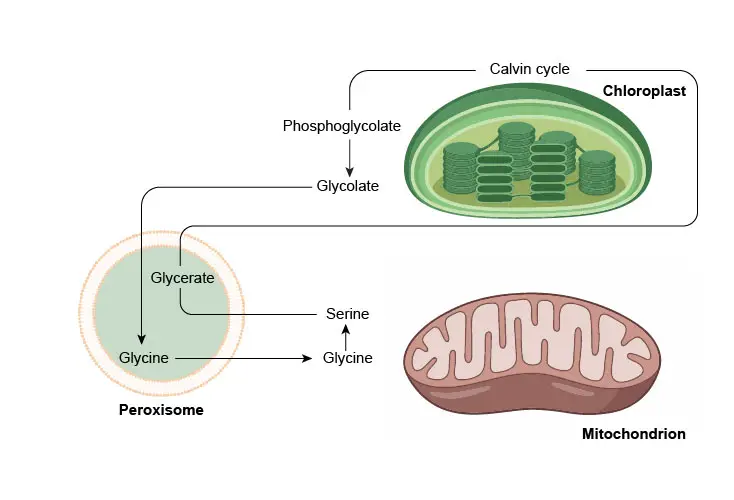
[In this figure] Photorespiration involves a complex network of enzyme reactions that exchange metabolites betwixt chloroplasts, leaf peroxisomes, and mitochondria.
Plasmodesmata
Plasmodesmata are microscopic channels that traverse the jail cell walls of plant cells and some algal cells, enabling transport and communication between them. Brute cells do not take plasmodesmata merely take other ways to communicate between cells, similar gap junctions or tunneling nanotubes (TNTs).
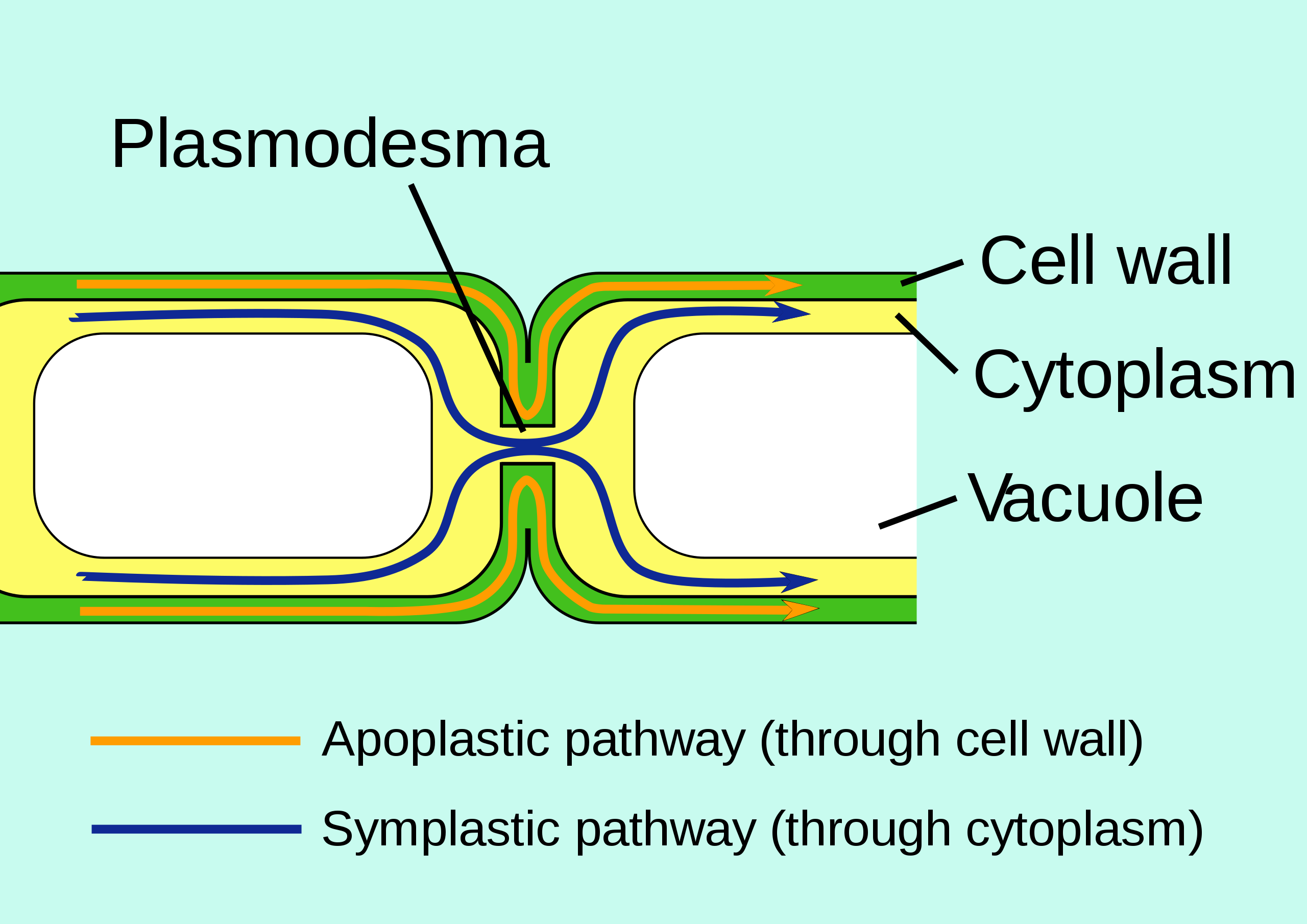
[In this figure] Plasmodesmata permit molecules to travel between institute cells through the symplastic pathway.
Photo source: wiki.
Flagella and Cilia
Two cellular structures that allow the move of animal cells, flagella, and cilia (singular: flagellum and cilium), are absent-minded in plant cells. Sperm cells are an excellent example of brute cells possessing flagella. Sperms use flagella for their movement toward the eggs. Cilia, on the other manus, act more similar brusque hairs moving back and along across the outside of the prison cell.
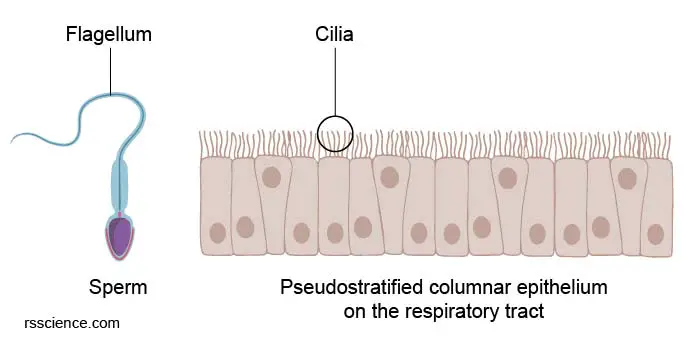
[In this figure] Cellular structures that allow the movement of animal cells: Flagellum (the tail of sperm) and Cilia (the waving hairs on the surface of airway cells).
Looking at animal and constitute cells under a microscope
You can hands find samples of fauna and found cells to look at under a microscope. See below to explore more than:
Cheek cells (more specifically, epithelial cells) form a protective barrier lining your mouth. All you lot demand to do is to gently scrape the within of the oral fissure using a clean, sterile cotton swab and then smear the swab on a microscopic slide to become the cells onto the slide.
You can run across our step-past-pace guide, "Look at your cheek cells."
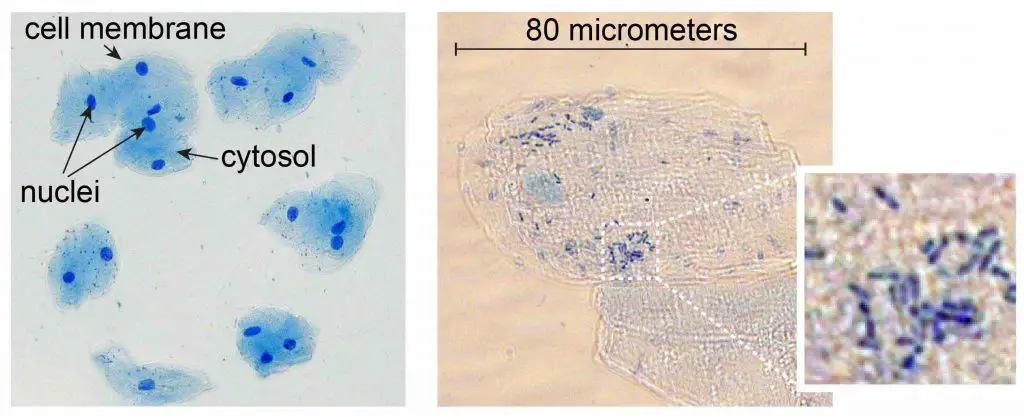
[In this figure]Cheek cells stained with Methylene Bluish.
The left paradigm is a low magnification. You can see the nuclei stained with a dark blue (because Methylene Blue stains DNA strongly). The cell membrane acts like a balloon and holds all the jail cell parts inside, such as a nucleus, cytosol, and organelles.
The right image is a loftier magnification. This bank check cell is well-nigh 80 micrometers in diameter. Yous tin can besides see some small rod-shaped bacteria on the right image. Don't worry; they are normal oral microbes.
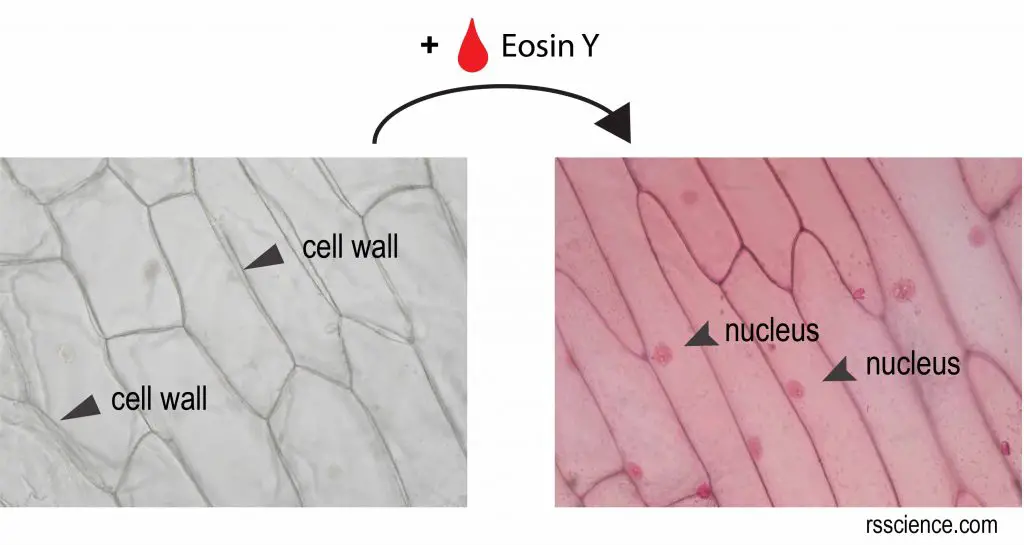
[In this figure]Microscopic view of onion peel.
The onion peel is a layer of protective epidermal cells against viruses and fungi that may harm the sensitive found tissues. This layer of peel is transparent and easy to pare, making it an ideal field of study to report establish cell construction. Without stains, y'all tin can only come across the cell walls of onion cells. By staining Eosin Y, now you can come across a nucleus inside an onion cell.
You can follow our footstep-past-step guide, "Expect at the Plant Cells" to prepare your own onion skin slide.
Q&A: frequently asked questions are quickly answered here
What do found cells have, but animal cells exercise non?
In cursory, the well-nigh hit difference between beast cells and plant cells is that institute cells have iii unique organelles: central vacuole, cell wall, and chloroplast.
What do animal cells have, simply plant cells practice not?
Animal cells take centrioles/centrosomes that nearly establish cells don't. Some animal cells besides have flagella and cilia, which are absent in plant cells.
What does a plant prison cell look like?
Due to the prison cell wall, many institute cells accept a rectangular stock-still shape.
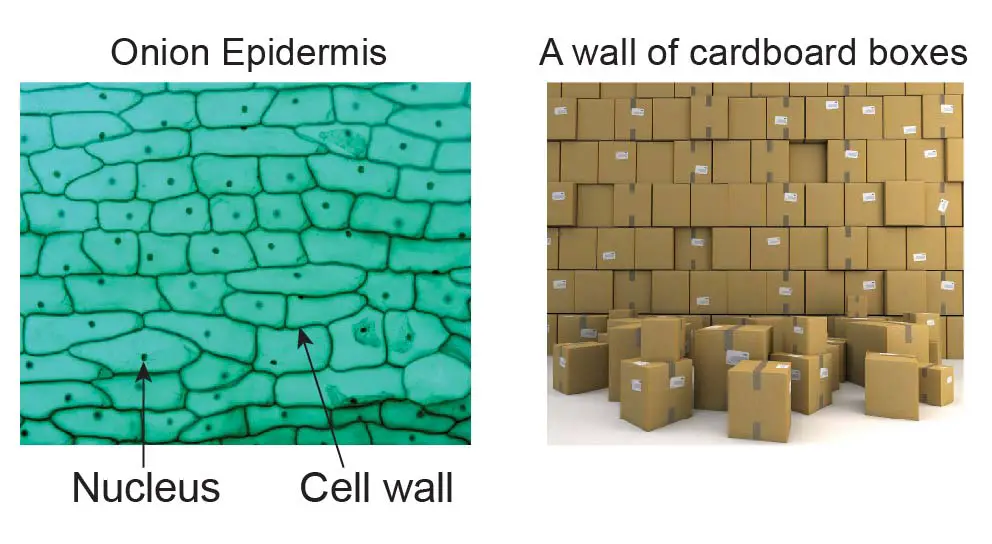
[in this effigy]The illustration of the cell wall.
The cell wall acts like a cardboard box that protects the soft jail cell membrane and cytoplasm. Like existent paper-thin boxes tin can be piled up to build a tall wall, the plant grows by adding cells ane by i as living building blocks. The weight is loaded primarily on the structural jail cell walls.
Do plant cells have jail cell membranes?
Yep, institute cells take a layer of cell membrane underneath the cell wall. The prison cell membrane detaches from the cell wall under a hypertonic condition.

[In this figure] Turgor pressure level on plant cells diagram.
Photo source: wiki.
Practise plant cells have mitochondria?
Yes, both animal and plant cells accept mitochondria, but simply plant cells have chloroplasts. In establish cells, chloroplasts absorb free energy from sunlight and shop it in the form of sugar (a procedure chosen photosynthesis). In dissimilarity, mitochondria use chemical free energy stored in sugars as fuels to generate ATP (chosen cellular respiration). Like animal cells, plant cells use ATP to drive other cellular activities.
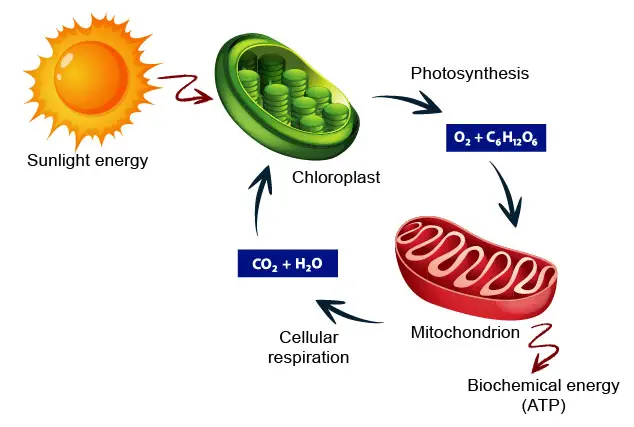
[In this figure] The carbon cycle showing how energy flows between chloroplasts and mitochondria to benefit the ecosystem.
Practice animal cells have a cell wall?
No, animal cells do not have a cell wall so they tin freely modify their prison cell shapes.
Practice plant cells accept centrioles?
No, plant cells practise not have centrioles for their mitosis except for some lower establish forms.
Do plants take lysosomes?
The presence of lysosomes in plant cells is nether debate. Vacuoles in plant cells can fulfill the part of animal lysosomes.
Do found cells have ribosomes?
Yes, institute cells have both free and endoplasmic reticulum-bound ribosomes for protein synthesis.
What practise all cells have in mutual?
All cells (prokaryotic or eukaryotic; animal or plant) share 4 common components: (ane) Plasma membrane, an outer covering that separates the prison cell's interior from its surrounding surround.
(ii) Cytoplasm, consisting of a jelly-similar region within the prison cell in which other cellular components are establish.
(iii) Dna, the genetic fabric of the cell.
(iv) Ribosomes, particles that synthesize proteins.
All cells on Earth accept similar chemical compositions and run into the clarification of jail cell theory. The central dogma of molecular biological science as "Deoxyribonucleic acid makes RNA, and RNA makes protein" is also truthful in all cells.
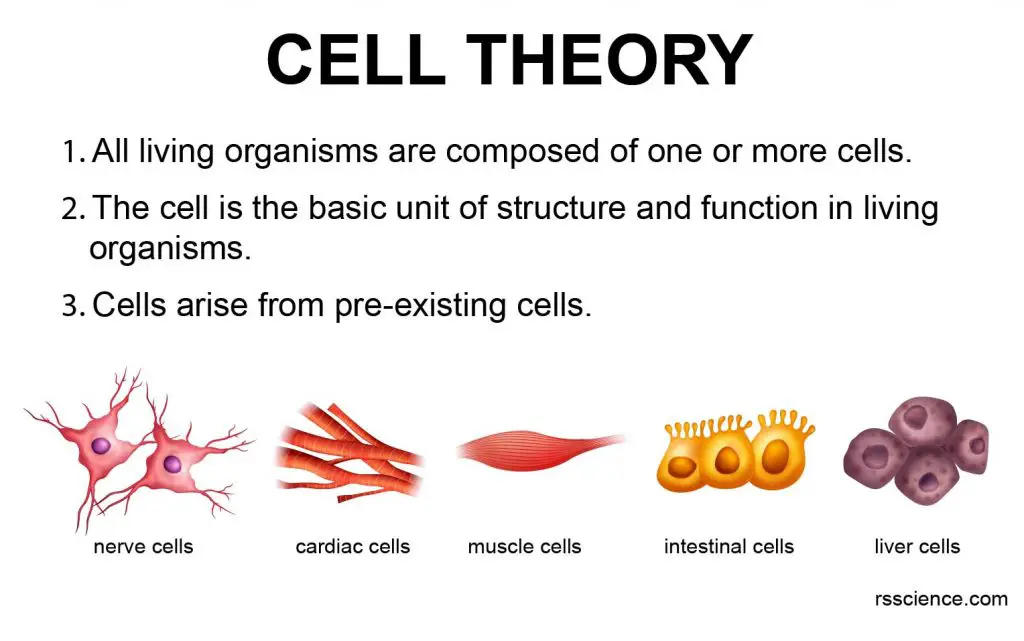
Are plants eukaryotic?
Yes, both plants and animals are eukaryotes and have membrane-bound nuclei and organelles. Prokaryotic cells are leaner and archaea.
Practise creature cells take chloroplasts?
No, animals do not have chloroplasts, and then they can not produce their nutrient. Notwithstanding, some animals may infringe chloroplasts and live like a institute. Elysia chlorotica (common name the eastern emerald elysia) is 1 of the "solar-powered body of water slugs," utilizing solar energy to generate energy. The sea slug eats and steals chloroplasts from the alga Vaucheria litorea. The bounding main slugs then incorporate the chloroplasts into their ain digestive cells, where the chloroplasts continue to photosynthesize for up to nine months.
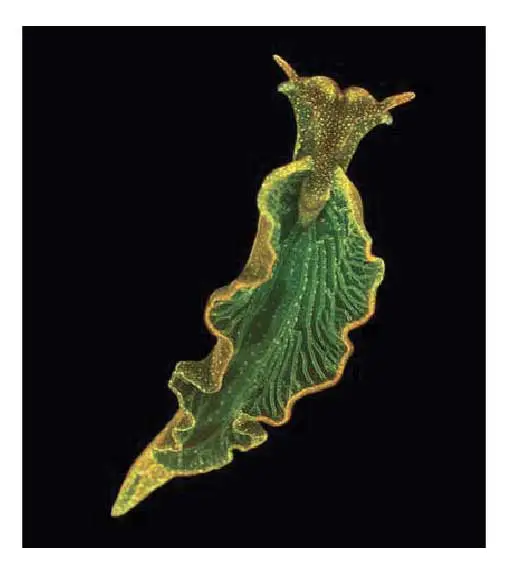
[In this figure] Elysia cholorotica , a bounding main slug found off the U.S. East Declension, tin steal photosynthetic chloroplasts from algae.
Photo source: Mary S. Tyler/PNAS
Practise plant cells have cytoskeleton?
Yes, both plant and animate being cells take a similar cytoskeleton. Constrained by the jail cell wall, the constitute jail cell's cytoskeleton does not allow a dramatic alter of the cell shape. However, the cytoskeleton network of actin filaments, microtubules, and intermediate filaments generate shape, construction, and organization to the cytoplasm of the establish prison cell. The cytoskeleton also drives the cytoplasmic streaming in institute cells.
How does cytokinesis differ in plant and beast cells?
Cytokinesis occurs in mitosis and meiosis in both plant and animal to separate the parent prison cell from girl cells.
In plants, cytokinesis occurs when a cell wall forms in between the daughter cells. In animals, cytokinesis occurs when a cleavage furrow forms. This pinches the cell in half.
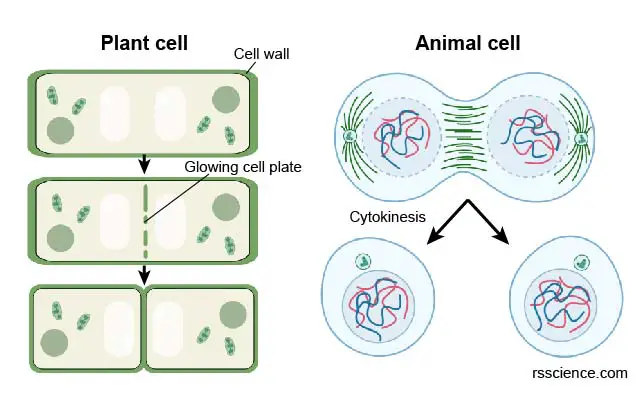
[In this figure] The difference of cytokinesis in plant and creature cells.
Source: https://rsscience.com/animal-cells-vs-plant-cells/
Posted by: stewartzies1964.blogspot.com

0 Response to "What Structures Do Animal Cells Have That Plants Don't"
Post a Comment